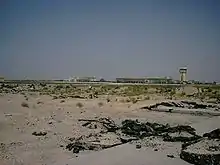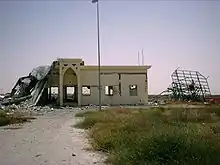Yasser Arafat International Airport
Yasser Arafat International Airport (Arabic: مطار ياسر عرفات الدولي Maṭār Yāsir 'Arafāt ad-Dawli), formerly Gaza International Airport and Dahaniya International Airport, is located in the Gaza Strip, in between Rafah and Dahaniya, close to the Egyptian border. The facility, which opened on 24 November 1998,[1] ceased operation during the Second Intifada on 8 October 2000.[2][3] The radar station and control tower were bombed by an Israeli attack.
Yasser Arafat International Airport مطار ياسر عرفات الدولي (Closed) | |||||||||||
|---|---|---|---|---|---|---|---|---|---|---|---|
 | |||||||||||
| Summary | |||||||||||
| Airport type | Defunct | ||||||||||
| Operator | State of Palestine | ||||||||||
| Location | Gaza Strip | ||||||||||
| Opened | 24 November 1998 | ||||||||||
| Closed | February 2000 | ||||||||||
| Elevation AMSL | 98 m / 320 ft | ||||||||||
| Coordinates | 31°14′47″N 34°16′34″E | ||||||||||
| Runways | |||||||||||
| |||||||||||
History
It is owned, and was operated, by the State of Palestine, and served as the home airport for Palestinian Airlines. It was able to handle 700,000 passengers per year and operated 24 hours and 364 days a year. The total area of the airport is 235 hectares (2.35 km2).[4] The airport closed in 2001 after being severely damaged by the Israel Defense Forces. Its destruction left Gaza Airstrip as the only serviceable runway in Gaza, until it was abandoned in 2004. The closest public airports in the area are the Ben Gurion Airport in Israel and the El Arish Airport in Egypt.
The construction of the airport was provided for in the Oslo II Agreement of 1995. The airport was built with funding from Japan, Egypt, Saudi Arabia, Spain, and Germany and designed by Moroccan architects (modeled after Casablanca airport) and engineers funded by Morocco's King Hassan II. The total cost was $86 million and it was built by Usama Hassan Elkhoudary (El-Khoudary for engineering and contracting). After a year of construction, it opened on 24 November 1998; attendees at the opening ceremony included Yasser Arafat and US President Bill Clinton. At the time, the opening of the airport was described as evidence of progress toward Palestinian statehood.[5] The airport got international airport codes (IATA: GZA, ICAO: LVGZ). The airport was twinned with Mohammed V International Airport, in Casablanca, Morocco.
The radar station and control tower were destroyed by the Israeli Air Force on 4 December 2001, after the start of the al-Aqsa Intifada. Bulldozers cut the runway apart on 10 January 2002.[6][7][8] From 2001 to 2006, airport staff still manned the ticket counters and baggage areas,[8] although no aircraft flew into or out of the airport during that period.
The International Civil Aviation Organization (ICAO) strongly condemned Israel for the destruction of the airport, which it deemed a violation of the Convention for the Suppression of Unlawful Acts against the Safety of Civil Aviation (Montreal Convention, 1971). The ICAO also urged Israel to take measures to restore the facility to allow its reopening.[6]
On 22 July 2010, 7,203 Gazan children between the ages of 6 and 15 participated in setting a new Guinness World Record for the simultaneous dribbling of basketballs on the airport's undamaged ramp.[9][10]
Gallery
 Damaged building
Damaged building Yasser Arafat International Airport
Yasser Arafat International Airport 2008 satellite photo of the runway
2008 satellite photo of the runway
References
- A Political Chronology of the Middle East. Europa Publications. 2006. p. 186.
- "Gisha" (PDF).
- Ruwantissa Abeyratne (2015). Aviation and International Cooperation: Human and Public Policy Issues. Springer. p. 85.
- Global Security (2009). Gaza International Airport. Retrieved on 2009-10-08 from http://www.globalsecurity.org/military/world/palestine/gip.htm.
- Palestinians cheer airport as first step to statehood, Associated Press, 25 November 1998.
- ICAO Council adopts resolution strongly condemning the destruction of Gaza International Airport Archived 22 February 2014 at the Wayback Machine. ICAO, 13 March 2002. On UNISPAL:
- Grounded in Gaza, but hoping to fly again, NBC News, 19 May 2005
- Years of delays at Gaza airport, Alan Johnston, BBC News, 15 April 2005
- "Gaza kids set basketball record". aljazeera.net.
- Gaza children set world record for basketball. YouTube. 22 July 2010.
| Wikimedia Commons has media related to Yasser Arafat International Airport. |